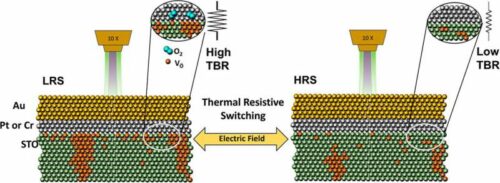Unveiling an approach to controlling thermal resistance, by a voltage-based method that significantly modifies how heat is managed in electronic devices.

Researchers at the Center for Research in Biological Chemistry and Molecular Materials (CiQUS) have discovered a method to modulate thermal resistance in devices by applying voltage. The research, led by Rafael Ramos and Francisco Rivadulla, was published in the journal ACS Applied Materials & Interfaces.
The team’s work focuses on developing materials with adjustable thermal conductivity, which could solve issues such as heat dissipation in electronic components, particularly in memristors. Memristors are components that exhibit a resistive switching effect, meaning their level of electrical resistance can be altered by applying an electric field. The researchers found that this resistive switching also triggers a thermal resistive switching effect at the metal-oxide interface of the material, caused by the accumulation of oxygen ions. This change in heat flow resistance can be adjusted by approximately 20% at room temperature.
This research is part of the MEMTHERM project, which aims to develop new thermoregulators that operate by controlling ion movement in dielectric oxides. The findings suggest a new way to enhance performance and sustainability in technologies where managing heat flow is crucial, potentially impacting everything from mobile phones to processors in significant ways.
Víctor Álvarez, a Ph.D. candidate at CiQUS and the study’s lead author, explained the process. “Oxides are materials whose thermal resistance is highly sensitive to oxygen concentration. By inducing a displacement of these ions with an electric field, we can alter their thermal properties,” he said. The study demonstrates that the thermal conductivity of the device can be reversibly increased or decreased, depending on its resistive state and the application of an electric field.






